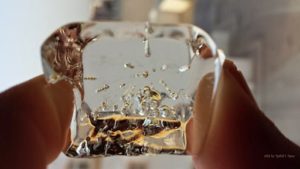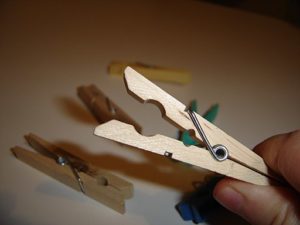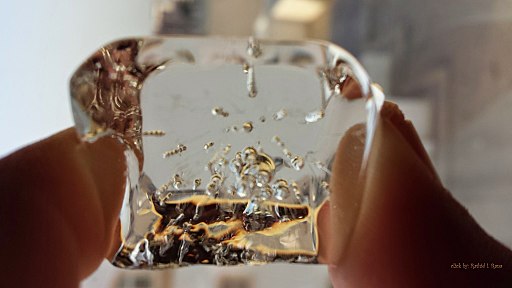In many childbirth classes, and sometimes, in a doula’s prenatal visit with a client, there are ice cubes. I saw ice cubes in my training when I became a Lamaze educator and ice cubes in various professional development workshops.
So what gives?
 The ice is given to pregnant people and their partners to simulate the pain of a contraction. People are supposed to hold the ice cube in their closed hand for 60 seconds, the length of an active labor contraction. While they are holding the ice, the people are to use their coping skills to deal with the pain. Skills like breathing, relaxation, distraction and so on. The intent is to show that you can deal with longer term discomfort and come through it unscathed.
The ice is given to pregnant people and their partners to simulate the pain of a contraction. People are supposed to hold the ice cube in their closed hand for 60 seconds, the length of an active labor contraction. While they are holding the ice, the people are to use their coping skills to deal with the pain. Skills like breathing, relaxation, distraction and so on. The intent is to show that you can deal with longer term discomfort and come through it unscathed.
I’ve also seen clothespins passed around to pregnant women and couples. Clothespins have made their appearance at professional development trainings too. The intent of the clothespins is the same. Pinch the skin with the clothespin and wait 60 seconds to simulate a contraction and see how well you cope with the pain.
Both of these techniques leave a very sour taste in my mouth. I think there are better and safer ways to teach new parents abo
ut how to cope with pain. I don’t, and won’t, use ice or clothespins with my students or clients.
Why not ice or clothespins?
Raynaud’s disease is a problem for some people, myself included. This disease means that people like me are dangerously cold sensitive. We are easily at risk for frostbite, when others are not. We lose circulation in our extremities very quickly and when the blood does return, we are in pain and swollen for minutes or hours afterwards. Someone with Raynaud’s ought not to be holding onto ice cubes like this.

Intentionally causing pain to yourself is not usually a good idea. It can be triggering for some. For those who have self-harmed in the past or who currently self-harm, holding ice or pinching with a clothespin becomes a new form of self-harm. It can re-trigger old patterns, or bring up memories of unhealthy behaviors.
Intentionally causing pain can also create feelings of anger, frustration, sorrow, failure and any other negative term you should choose to use.
Intentionally causing pain to your partner is a bad move. Asking the partner to pinch a pregnant mother with a clothespin is risky. Ditto that having him give her the ice and coach her to stay with her pain. What if he is abusing her at home? What if she’s abusing him? This can be triggering or further damaging to their relationship. It can undermine trust students have in their teacher, who is not only condoning harming the other person, but actively encouraging it. By asking a couple to harm each other, you are implicitly saying that it’s acceptable to harm the other person. In a group environment, there is peer pressure to perform. A woman in a bad home situation may not speak up for her pain, but suffer silently.
A teacher who asks a student to harm themselves or to harm another is not teaching, they are harming their students.
Then there is that other aspect of pain and pleasure. Both ice cubes and clothespins are used in sex play. If a couple is into such things, you asking them to use one or the other in class brings up a very different connotation. Granted, you can’t take the sex out of birth, because birth is, inherently a sexual act (sexual reproduction, anyone?). However, for some folks, ice cubes and clothespins are used for fun and for those folks, the intention of the activity in the classroom won’t come through in the way the instructor has planned.
What to do instead?
There are a myriad of different things to do to help new parents cope with painful or stressful situations, be that situation, birth, dental pain, loss of a loved one or something else. Pain coping skills are life skills, not birth skills alone.
We don’t need to cause pain to teach people to cope with pain.
We can remind students of what they already know about dealing with pain, since no one gets through life pain-free. We can show quality birth videos on how people cope with labor. We can have open Q&A time to let our students ask us about pain and their concerns surrounding it. We can teach all of the pain coping skills: movement, massage or touch, distraction, breath, sound, pain medications etc.
There are any number of things we can do that causes no harm to our students. Tell me, in the comments, what do you use in your classes? Or, what did your childbirth education teacher use that you found helpful?
Want to learn more?
You can become a Lamaze Certified Childbirth Educator and I’ll help guide you in how to best reach the students in front of you.
As a pregnant parent, you can take our Confident Birthing class and learn for yourself how to handle your pain and so much more!

I also feel that using something that causes pain is mentally misleading and doesn’t translate to the discomfort one feels during childbirth. Pain signals that something is wrong. Holding an ice cube and or pinching with a clothespin, is painful because it is unnatural and your nervous system is sending out a warning. In natura childbirth, discomfort is part of the process and it is how one is supposed to feel. It means your body is working well. Not the same as “pain” at all.
You are absolutely spot on here. Pain when something is wrong with your body is very different than the work that is labor. Thank you for mentioning this.
I can only conclude that the author has no real understanding of the reason for ice practice, has never experienced properly lead ice practice, or just has a chip on her shoulder about the practice.
Of *course* ice can’t replicate labor- it would be unethical to expect parents to go through the full intensity of labor in a class. But it is *also* unreasonable to expect parents to practice relaxing, calming practices in a classroom, with nothing to work with, and then expect them to use those techniques effectively in the thick of labor.
Properly done, ice ‘contractions’ give parents a frame of reference for how their pain coping practices are working for them, it shows them that they can and will be able to meet the challenges of labor, because they can see and feel it working with a smaller, less intense physical challenge. They can *know* that their body is integrating and using the pain coping skills.
And this idea that someone who uses ice in a sexual context won’t be able to use ice in class without feeling hot and bothered is disingenuous at best, and kink-shaming at worse. People use massage during sex, too, and no one suggests that learning massage in a childbirth class is sexual.
I do have a good understanding of the ice practice. I’ve been in the business for 10 yrs and I’m a Lamaze Program director, training new educators. So, your initial conclusion is erroneous.
This is not about me having a “chip on my shoulder” about the practice. This is about my aversion to causing harm to our students. I think there are far better ways to teach pain coping skills than by causing a degree of pain and asking them to use the skills to deal with it.
I never said what I did to teach pain coping skills in this blog post, so it’s an interesting assumption you make that I either teach none or teach ineffectively. We can teach pain coping by reminding people of the skills they already have for pain (headaches, stress, death of a loved one, broken bone, etc). Everyone has life experience with pain that is directly applicable to how they cope with birth. There are inclusive ways to bring that out in class or through homework to let them know how big their toolbox of pain coping skills really is.
Practicing labor postures and other physical comfort skills in class can be done without causing pain. Humans have a lovely ability to imagine and know how this position or massage helps with pain, but you have to put it in context.
You can also show birth videos and discuss the pain coping skills therein. The visual of real women in labor and the debrief afterwards go a long way to putting the pain in context.
There are many other ways to illustrate a woman’s ability to cope other than by causing her pain. If you cause her pain, you are doing harm. That is antithetical to helping and to educating.
With regards to your final statement about sexual context – I think you miss the triggers here. No one is going to get “hot and bothered” in class. It trips a memory or a feeling and maybe a giggle. There is no kink-shaming here either. Remember, birth is a sexual event. It is the end of the sex act, hence the term sexual reproduction. You can’t take the sex out of birth but you can address the sexuality of birth in a safe manner as well.
So, while I appreciate your taking the time to comment, I would ask you to consider your defensiveness. You use ice. I’ve brought up reasons why I think ice and clothespins are harmful. I’ve triggered you because I’ve caused you to question your practices. Ego is a big thing. Doctors still do episiotomies frequently or induce early because that’s what they’ve always done. Knowing those sort of things aren’t evidence based practices don’t change their behavior because then they’d have to admit they’d caused harm to many people. This is no different. Practices that cause pain, cause harm. It’s hard to admit causing harm to people. Changing how you teach makes that admission.
There are other and better ways to teach about labor pain and coping skills. Ice, clothespins or other things that cause harm are not the best way, nor any way that I’d coach my Lamaze trainees to teach.
Ahh, I see. In your mind all ‘pain’ is harm and suffering. There’s no room in your worldview for the physical sensation of ice to be a judgement-free, neutral experience that supports learning and growth. You assume that my “ego” has been threatened, and that you’ve made me “question” my beliefs and practices. Far from it, you’ve just further emphasized the need for realistic, comprehensive childbirth education that doesn’t automatically label all pain as the boogieman, that teaches there’s a difference between ‘pain’ and ‘suffering’, and doesn’t promise magical, pain-free births.
Nope, you are quite wrong on my views of pain vs. suffering. You’ve obviously not read anything else I’ve written, ever. You assumption is actually antithetical to how I teach my childbirth classes. You’ve also not read anything else on my website, my class descriptions or even my bio.
In fact, we’ve never met (to my knowledge) and you are making huge leaps of judgement based on one practice in class which I condemn.
What you are truly missing is that we are in agreement here “need for realistic, comprehensive childbirth education that doesn’t automatically label all pain as the boogieman, that teaches there’s a difference between ‘pain’ and ‘suffering’, and doesn’t promise magical, pain-free births.” That is exactly how I teach my classes.
I’ll suggest you start with these posts and explore the other things I’ve written both here on Shining Light’s blog and in all of my other additional writings. That’ll help elucidate how incorrect your assumption actually is.
On the Transformative Power of Pain During Childbirth
It’s not the Method, it’s the Mother.
Perfection vs. Purpose OR the Birth Experience vs. Giving Birth
Hi Deena, thank you for this post. It is thought provoking and has some really interesting points. I use ice in my classes too, and I have never thought of people being too sensitive to it. I suppose I expect a certain amount of self responsibility there and no one would ever be forced to do anything in my class.
I use ice, because what I am trying to teach parents or make them aware of, is their response, their emotional or internal response to discomfort. This cannot be taught by other methods I believe, but would love your opinion and suggestions if you do think so. The process is to make parents aware of where their mind goes when they feel discomfort. Because this is highly relevant in how they are going to react in labour. The pain is not the same, the intensity is not the same, but the way the mind tries to avoid the feeling is similar.
I would never get a partner to inflict the pain. You are absolutely right, that is not a good idea. And has so many pittfalls I would even begin. You mentioned quite few good ones.
The sexual thing I think is personal responsibility too. I can’t consider all peoples weird and wonderful habits and ways and life circumstances. I think doing ice though, is such a beautiful portal to a conversation that would be very needed in preparation for birth, whether it is disease, sex or life situation. Maybe some people are not good candidates for ice holding and that is an entrance to start some healing and some solutions for how to manage those circumstances during and after labour. Self harmers too. We can’t shelter everyone from everything and all feelings and triggers. Better to be triggered right now than in the middle of labour.
I think you had some really interesting points that I will bring with me to classes and in my awareness of the parents I come into contact with. So thank you for that. I don’t think you have the whole and deeper picture of using ice. I think clothes pegs are a different story as they just inflict pain. Ice creates a sensation more than just pain. I will continue to use ice, as I think there are too many awesome opportunity for growth for the parents in my classes. Thank you 🙂
So as someone who gave birth twice and only did the “Ice Cube Contractions” experiment AFTER I’d already had the babies I will say this: it helped me to understand that the way I was best able to cope with pain was not the way most people were trying to help me.
During labor I was trying all the suggestions, positions, breathing methods and mantras and I was not able to cope with the pain sufficiently. I ended up requiring an epidural.
Now I’m training as a Doula and when we did the ice cube contractions I actually found it fascinating. We were taken through multiple techniques and there were definitely times where the only thing keeping me from dropping the ice cube was the peer pressure (Nothing like being the only one in the room who got an epidural to make you feel like you have to “prove” you can take the pain!) but ultimately I found that what works best for me is completely counter the most popular suggestions.
I still wonder if I had known this and let go of how I was “suppose” to be handling it if I could have given birth without the epidural, but I didn’t know and no one can change the past.
I will keep in mind your thoughts on the subject and definitely I will seek unformed consent before introducing the exercise to clients but I honestly feel like it would have better prepared me for my birth experience and thus will be a helpful tool of self discovery with clients.
Food for thought – If what kept you from dropping the ice cube in class was peer pressure, then does it really work to simulate coping in labor? There is no peer pressure in labor. It’s you and your body. Peer pressure gives us feelings of guilt or inferiority. It doesn’t help us to develop internal coping skills.
There are far better ways to teach coping skills than to induce pain in our classrooms or with our clients. I’d encourage you to get creative in ways that don’t cause pain, but still require the student/client to recall her coping skills and to use them effectively.